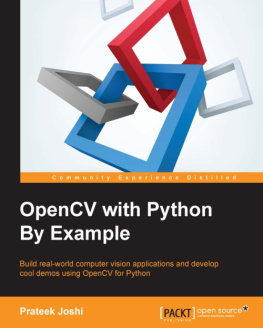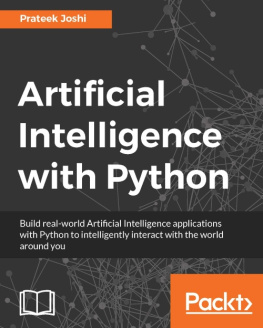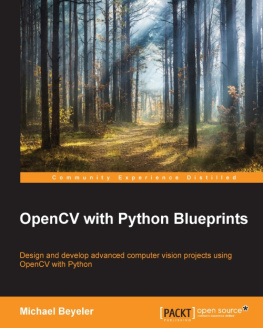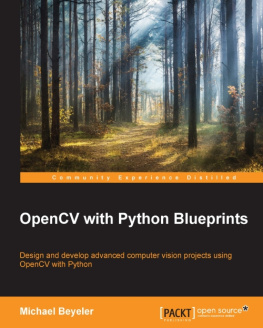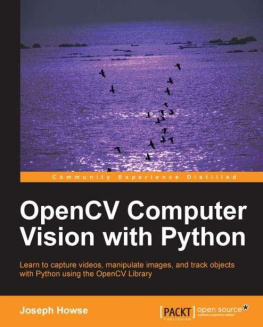Prateek Joshi - OpenCV with Python By Example
Here you can read online Prateek Joshi - OpenCV with Python By Example full text of the book (entire story) in english for free. Download pdf and epub, get meaning, cover and reviews about this ebook. year: 2015, publisher: Packt Publishing, genre: Computer. Description of the work, (preface) as well as reviews are available. Best literature library LitArk.com created for fans of good reading and offers a wide selection of genres:
Romance novel
Science fiction
Adventure
Detective
Science
History
Home and family
Prose
Art
Politics
Computer
Non-fiction
Religion
Business
Children
Humor
Choose a favorite category and find really read worthwhile books. Enjoy immersion in the world of imagination, feel the emotions of the characters or learn something new for yourself, make an fascinating discovery.
- Book:OpenCV with Python By Example
- Author:
- Publisher:Packt Publishing
- Genre:
- Year:2015
- Rating:4 / 5
- Favourites:Add to favourites
- Your mark:
OpenCV with Python By Example: summary, description and annotation
We offer to read an annotation, description, summary or preface (depends on what the author of the book "OpenCV with Python By Example" wrote himself). If you haven't found the necessary information about the book — write in the comments, we will try to find it.
Abstract: Build real-world computer vision applications and develop cool demos using OpenCV for PythonAbout This Book Learn how to apply complex visual effects to images using geometric transformations and image filters Extract features from an image and use them to develop advanced applications Build algorithms to help you understand the image content and perform visual searchesWho This Book Is For This book is intended for Python developers who are new to OpenCV and want to develop computer vision applications with OpenCV-Python. This book is also useful for generic software developers who want to deploy computer vision applications on the cloud. It would be helpful to have some familiarity with basic mathematical concepts such as vectors, matrices, and so on. What You Will Learn Apply geometric transformations to images, perform image filtering, and convert an image into a cartoon-like image Detect and track various body parts such as the face, nose, eyes, ears, and mouth Stitch multiple images of a scene together to create a panoramic image Make an object disappear from an image Identify different shapes, segment an image, and track an object in a live video Recognize an object in an image and build a visual search engine Reconstruct a 3D map from images Build an augmented reality applicationIn Detail Computer vision is found everywhere in modern technology. OpenCV for Python enables us to run computer vision algorithms in real time. With the advent of powerful machines, we are getting more processing power to work with. Using this technology, we can seamlessly integrate our computer vision applications into the cloud. Web developers can develop complex applications without having to reinvent the wheel. This book will walk you through all the building blocks needed to build amazing computer vision applications with ease. We start off with applying geometric transformations to images. We then discuss affine and projective transformations and see how we can use them to apply cool geometric effects to photos. We will then cover techniques used for object recognition, 3D reconstruction, stereo imaging, and other computer vision applications. This book will also provide clear examples written in Python to build OpenCV applications. The book starts off with simple beginners level tasks such as basic processing and handling images, image mapping, and detecting images. It also covers popular OpenCV libraries with the help of examples. The book is a practical tutorial that covers various examples at different levels, teaching you about the different functions of OpenCV and their actual implementation. Style and approach This is a conversational-style book filled with hands-on examples that are really easy to understand. Each topic is explained very clearly and is followed by a programmatic implementation so that the concept is solidified. Each topic contributes to something bigger in the following chapters, which helps you understand how to piece things together to build something big and complex
Prateek Joshi: author's other books
Who wrote OpenCV with Python By Example? Find out the surname, the name of the author of the book and a list of all author's works by series.

